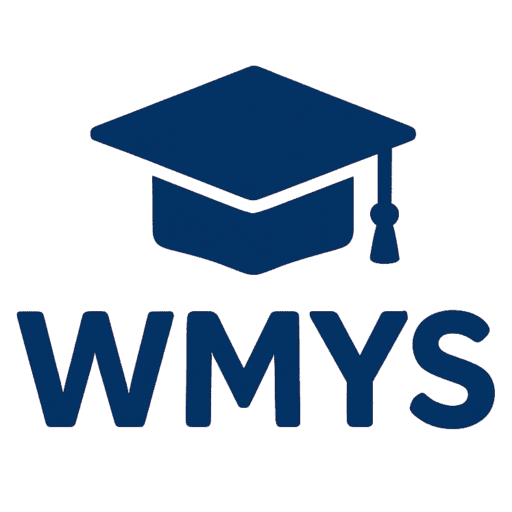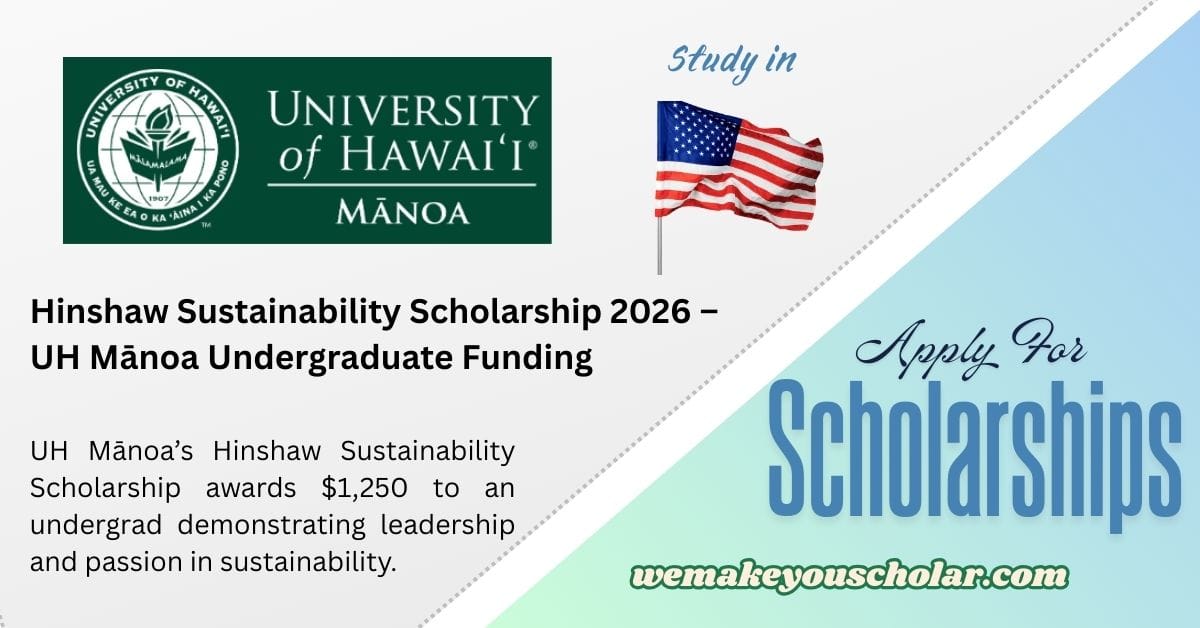Chancellor Virginia S. Hinshaw Scholarship in Sustainability (UH Mānoa)
Change on a campus rarely starts with a budget line; it starts with one determined student willing to pilot an idea, rally a few friends, and prove that small actions add up. The Chancellor Virginia S. Hinshaw Scholarship in Sustainability at the University of Hawaiʻi at Mānoa (UH Mānoa) exists for students like that—those who pair heart with a hands-on plan. This undergraduate award (often cited at $1,250) recognizes meaningful leadership and real-world impact in sustainability, whether the work is research-based, community-centered, policy-focused, or a blend of all three.
Why This Scholarship Matters
Sustainability at UH Mānoa has deep roots—interweaving Native Hawaiian values of mālama ʻāina (to care for the land), island resiliency, and cutting-edge research. Campus efforts stretch from food systems and water management to energy efficiency and climate action. The Hinshaw Scholarship amplifies that momentum by backing undergraduates who demonstrate not only strong ideas but the initiative to test, measure, and share results.
What “Sustainability” Means Here
For this award, sustainability isn’t limited to recycling bins or LED bulbs (though those matter). Think broadly:
- Environmental: biodiversity, energy, water, waste, climate adaptation, nature-based solutions.
- Social: health equity, food security, housing, cultural stewardship, disaster preparedness.
- Economic: circular economy pilots, green jobs pathways, cost-savings from efficient operations.
- Governance: policy proposals, data transparency, student governance, stakeholder coalitions.
Scholarship Snapshot (Student-Quick View)
- Award Name: Chancellor Virginia S. Hinshaw Scholarship in Sustainability
- Institution: University of Hawaiʻi at Mānoa
- Level: Undergraduate students at UH Mānoa
- Typical Award Amount: $1,250 (amount may vary at the University’s discretion)
- Focus: Student leadership and demonstrated impact in sustainability
- Who Should Apply: Undergraduates with a clear record (or a well-designed plan) of sustainability action that benefits UH Mānoa and community partners
Who Should Consider Applying?
If at least one of these statements rings true, you’re in the right place:
- You’ve led or co-led a campus sustainability initiative, and you can show what changed because of your work.
- You’ve designed a pilot project or research study focused on sustainability outcomes—ready to implement or already in progress.
- You volunteer with community organizations addressing food security, ecosystem restoration, or climate resilience, and you connect that work to UH Mānoa.
- You’re that person who turns frustration (“why is this system so wasteful?”) into a spreadsheet, a coalition, and a presentation to decision-makers.
Eligibility & Ideal Candidate Profile
Final eligibility is determined by the official program page (linked at the end), but this award generally targets UH Mānoa undergraduates who demonstrate:
- Leadership: initiating or guiding sustainability activities, clubs, coalitions, or research teams.
- Impact: measurable outcomes—reduced waste, increased access to healthy food, policy adoption, or research translated into practice.
- Integrity: community-minded approach, respect for cultural context, and responsible use of funds.
- Communication: clear writing, accessible outreach, and a plan to share findings with peers and stakeholders.
GPA & Major
This scholarship celebrates impact; strong grades help, but you won’t be screened out for not being a 4.0. All majors can be competitive—from engineering and natural sciences to social sciences, policy, business, and the arts—provided your work clearly advances sustainability at UH Mānoa or in Hawaiʻi.
What the Committee Wants to See (Selection Lens)
- Clear problem definition anchored in campus or community needs.
- Feasible plan with timeline, partners, and realistic scope for an undergraduate to manage.
- Metrics that matter (kWh saved, pounds of waste diverted, students reached, meals served, trees planted, policy milestones).
- Respect for place: attention to Native Hawaiian knowledge, local partners, and island realities.
- Shareability: how you’ll document and communicate results so others can replicate or scale.
How Much Funding & How It’s Typically Used
The award is commonly listed around $1,250 (subject to confirmation by UH Mānoa). Students usually direct funds to:
- Project materials (sensors, test kits, seedlings, compost equipment, signage, workshop supplies).
- Local travel to partner sites or research locations.
- Data and analysis (software, small equipment, printing for outreach).
- Event costs (room reservations, modest refreshments per policy, accessibility services, interpretation).
Pro tip: If your hardware spend is high, pair this scholarship with additional campus mini-grants or club funds to round out your budget.
Application Components (What to Prepare)
Exact requirements appear on the official page, but strong applications typically include:
- Personal statement (or project narrative) with a succinct problem statement, proposed solution, timeline, and metrics.
- Evidence of prior work (photos, links, short summaries of outcomes, letters from mentors or partners).
- Budget explaining how funds unlock results—show leverage (in-kind support, volunteer time, matched dollars).
- Resume highlighting leadership and relevant skills (GIS, data analysis, facilitation, outreach).
- Faculty or mentor endorsement attesting to feasibility and your reliability.
How to Write a Personal Statement That Wins
Begin with a Sharp Problem Statement
Forget the generic “I care about the planet.” Instead, anchor in something observable: “UH Mānoa’s food waste peaks during finals week, with compost bins filling 3× faster while contamination rises 40%.” Evidence-backed openings earn trust fast.
Map Your Solution to Measurable Outcomes
- Define actions (pilot peer-led sorting at three dining halls).
- Name outputs (student trainings, signage updates, bin audits).
- Choose outcomes (% contamination reduction, pounds diverted).
- Add co-benefits (student jobs, curricular tie-ins, mental health via community connection).
Show Collaboration & Cultural Context
Partner with campus units and local organizations; acknowledge and integrate Native Hawaiian stewardship values where relevant. Demonstrate that your work strengthens—not duplicates—existing efforts.
Close With Continuity
Share how you’ll sustain momentum after the funding cycle: onboarding materials, club adoption, a maintenance plan, or a request to institutionalize your pilot if targets are met.
Suggested Timeline (Sample)
- Weeks 1–2: Finalize scope, confirm partners, refine metrics, purchase supplies.
- Weeks 3–6: Launch pilot, collect baseline data, run trainings, adjust signage or workflows.
- Weeks 7–10: Monitor, troubleshoot, gather mid-point data, host one student showcase or teach-in.
- Weeks 11–12: Analyze results, present to stakeholders, publish a 2-page summary and toolkit.
Examples of Fundable Projects (Get Inspired)
Campus Operations
- Residence hall energy dashboards with competitions and monthly feedback loops.
- Zero-waste events toolkit + trained student “green teams” for large campus gatherings.
- Water refill mapping + behavior nudges where bottled sales spike.
Food Systems & Health
- Pop-up food pantry analytics to optimize hours, inventory, and outreach.
- Campus garden expansion with curriculum tie-ins (soil testing, biodiversity logs, cooking demos).
- Compost contamination reduction pilots with peer education at peak traffic times.
Climate Resilience
- Tree inventory & heat maps to prioritize shade equity along student routes.
- Emergency preparedness workshops with multilingual materials and accessibility checks.
Policy & Governance
- Procurement guidelines for low-waste events, surfacing quick wins and cost savings.
- Reusable labware pilot in collaboration with lab managers and EH&S.
Culture & Communication
- Student storytelling series featuring Indigenous knowledge and science collaboration.
- Onboarding module for new students on sustainability resources and opportunities.
Common Mistakes (And Easy Fixes)
- Vague outcomes → Specify metrics and how you’ll collect them.
- Oversized scope → Right-size to one semester pilot with clear hand-off plan.
- No partners → Add at least one campus unit or community group; include a contact.
- Budget bloat → Justify every line item; show quotes or alternatives when possible.
- No dissemination plan → Commit to a public summary, poster session, or toolkit.
Equity, Inclusion, and Cultural Respect
againImpact is stronger when everyone can participate. When you design your project:
- Include accessibility accommodations (ramps, captions, interpreters when needed).
- Offer materials in plain language; consider multiple languages when appropriate.
- Respect cultural practices and seek guidance when work intersects with sacred spaces or traditions.
Assessment & Sharing Your Results
Think like a communicator, not just a researcher:
- Data: keep methods simple and repeatable (counts, weights, attendance, short surveys).
- Visuals: one clear chart beats ten cluttered ones.
- Story: include one brief student or staff quote that humanizes the numbers.
- Packaging: publish a 2-page PDF summary + a one-slide infographic; share with campus partners.
Suggested Application Timeline (Working Backwards)
- 4–6 weeks out: Confirm partners, draft narrative, outline budget, gather baseline info.
- 2–3 weeks out: Edit statement, secure endorsement letter, get quotes for any purchases.
- 1 week out: Proofread, convert all files to PDF, confirm submission instructions.
- 48 hours out: Submit; do not cut it close. Double-check that uploads are complete.
Document Checklist (Print & Tick)
- ✔ Personal statement / project narrative (2–3 pages, concise headings)
- ✔ Resume (1–2 pages, impact bullets)
- ✔ Budget (table + brief justification)
- ✔ Evidence of prior work (photos, links, brief summaries)
- ✔ Faculty/mentor endorsement (1 page preferred)
- ✔ Any required forms per official page instructions
How to Align With Campus Priorities
Ask yourself: Does this help UH Mānoa meet a stated sustainability target? If yes, name the target. If not, explain the bridge: “This pilot fills a gap by testing X so Facilities can evaluate Y.” Translating student energy into institutional progress makes your proposal irresistible.
After You Receive the Award
- Kickoff: email partners, confirm budget procedures, finalize timeline.
- Mid-project check: share a brief update with photos or a chart; invite feedback.
- Final deliverables: post a public summary; thank supporters; suggest next steps.
Frequently Asked Questions (FAQs)
1) Is the Hinshaw Scholarship only for environmental majors?
No. Any undergraduate at UH Mānoa can be competitive. What matters most is a convincing sustainability impact—environmental, social, economic, or governance—tied to campus or community benefit.
2) How much is the award?
The scholarship is commonly referenced at $1,250. Always verify the current amount on the official UH Mānoa page linked below, as funding and criteria can change.
3) Can a team apply?
Student leadership is key, and many projects thrive with small teams. Name a primary lead, clarify roles, and include letters or emails from partners indicating support.
4) Do I need a faculty advisor?
While the official requirements govern, having a faculty or staff mentor strengthens feasibility and follow-through. A short endorsement letter can be highly persuasive.
5) What if my plan changes mid-project?
That happens in real work. Communicate quickly, document why, and adjust scope without hiding hiccups. Committees value transparency and problem-solving.
6) Can I use the funds for labor?
Follow UH Mānoa’s purchasing and funding rules. When in doubt, propose non-labor uses first (materials, data tools, accessibility) and ask the official contact how to handle student time or stipends.
7) How do I make my application stand out?
Lead with evidence, quantify outcomes, show partnerships, respect cultural context, and provide a synopsis others can reuse. Include a one-slide visual that “sells” the idea in 10 seconds.
Final Checklist Before You Submit
- My opening paragraph names a specific problem and includes a baseline metric.
- My solution includes feasible steps, a timeline, and measurable targets.
- I have at least one campus or community partner with a short endorsement.
- My budget ties each line item to an outcome; I added accessibility where appropriate.
- I planned how to share results (PDF summary, poster, or toolkit).
- I verified the official instructions and updated requirements on the UH Mānoa page.
Official Link
Always confirm current details, requirements, and deadlines on the official page:
Chancellor Virginia S. Hinshaw Scholarship in Sustainability – UH Mānoa (Official Page)




